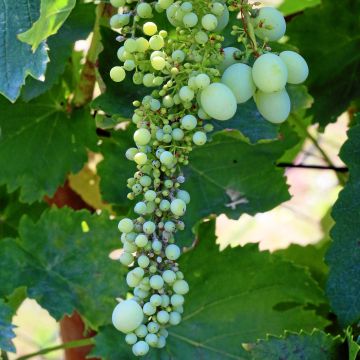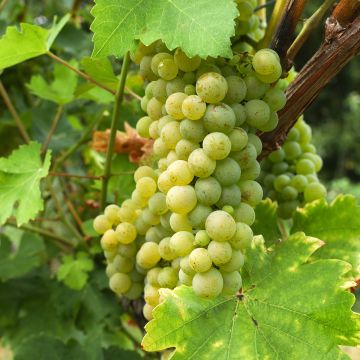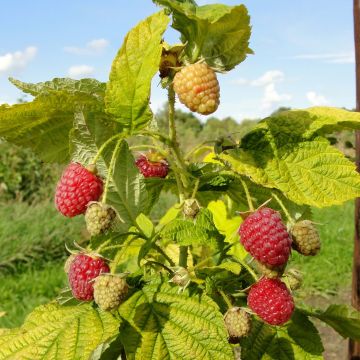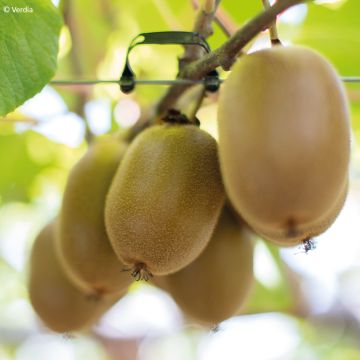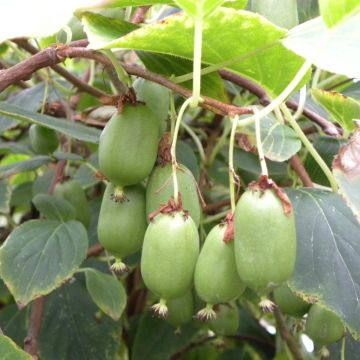

Vitis vinifera Nebbiolo - Grape vine
Vitis vinifera Nebbiolo - Grape vine
Vitis vinifera Nebbiolo
Grapevine, Common Grape Vine, European Grape, Wine Grape
This item cannot be shipped to the selected country
Delivery charge from €5.90
More information
Schedule delivery date,
and select date in basket
This plant carries a 6 months recovery warranty
More information
We guarantee the quality of our plants for a full growing cycle, and will replace at our expense any plant that fails to recover under normal climatic and planting conditions.
From €5.90 for pickup delivery and €6.90 for home delivery
Express home delivery from €8.90.
Description
The 'Nebbiolo' Vine is a highly renowned Italian black grape variety, used in the production of the finest wines from Piedmont. Barolo and Barbaresco are two notable varieties made exclusively from Nebbiolo. Under good growing conditions, this grape variety produces relatively acidic, highly tannic, moderately coloured wines of exceptional quality, capable of ageing. It is a delicate grape that matures late, usually in October. It requires excellent sun exposure, preferably facing southwest, from bud break to harvest. It prefers mainly limestone or clay-limestone soils with good drainage.
The wine grape vine (Vitis vinifera) grew wild over 5000 years ago. Numerous hybrids have been created to vary colours, flavours, and uses. The 'Nebbiolo' vine originates from Piedmont, Italy. Unlike many other major grape varieties, 'Nebbiolo' is geographically limited. Some excellent wines can be found in Baja California and Arizona, but the reputation of this grape variety is firmly rooted in the Piedmont region, where it often produces wines that evolve over several decades.
A vigorous climbing plant, the 'Nebbiolo' vine can reach up to 5m. Its final shape will depend on the pruning method used. The vine naturally clings to its support (trellis, espalier...) thanks to its tendrils and thrives in sunny locations. It has a semi-erect to horizontal habit. It is recommended to train it on wire and trellis it properly. It requires careful pruning.
Its deeply cut foliage is a vibrant green in summer, with the edges of its leaves turning red in autumn.
It flowers in clusters of tiny white-pink flowers in May.
The clusters and berries of Nebbiolo are small to medium-sized. The berries are round or slightly ellipsoidal. The skin of Nebbiolo seeds is thin. It is susceptible to grey rot and powdery mildew.
Nebbiolo is an extremely demanding grape variety with regard to soil and exposure, it is as delicate to cultivate as it is to vinify, as it requires frequent monitoring. It produces exquisite single-varietal wines that, when mature, offer complexity and length rarely matched. These wines are astringent in their youth and deserve a few years of ageing before being enjoyed. Its floral, fruity, and spicy notes are often combined with more unique flavours such as chocolate or mushroom. It typically produces wines with an intense garnet colour and slight orange reflections, high in alcohol, with very astringent tannins.
The grapes are consumed as wine after vinification.
Report an error about the product description
Plant habit
Fruit
Flowering
Foliage
Botanical data
Vitis
vinifera
Nebbiolo
Vitaceae
Grapevine, Common Grape Vine, European Grape, Wine Grape
Western Europe
Other Grapevines
Planting and care
Since the devastation caused by phylloxera at the end of the 19th century, the vine has been grafted onto different rootstocks resistant to this disease and adapted to different types of soil. These rootstocks come from American varieties. Plant the 'Nebbiolo' vine in autumn, in a deep, well-drained soil, even stony, arid, poor and chalky, in a sunny exposure, sheltered from strong winds. Incorporate 3 or 4 handfuls of fertiliser for fruit trees and 2 kg of composted manure into the planting soil for each plant. The roots must not be in contact with the manure. After planting, prune above 2 large buds (buds) to obtain the growth of two branches. Keep the most vigorous one, and tie it to a stake. The training pruning will follow.
The vine does not require regular fertiliser application, for good yield, on the contrary. Enrich the soil with potash, crushed horn or iron chelate, only every 2-3 years.
Planting period
Intended location
Care
This item has not been reviewed yet - be the first to leave a review about it.
Berries
Haven't found what you were looking for?
Hardiness is the lowest winter temperature a plant can endure without suffering serious damage or even dying. However, hardiness is affected by location (a sheltered area, such as a patio), protection (winter cover) and soil type (hardiness is improved by well-drained soil).

Photo Sharing Terms & Conditions
In order to encourage gardeners to interact and share their experiences, Promesse de fleurs offers various media enabling content to be uploaded onto its Site - in particular via the ‘Photo sharing’ module.
The User agrees to refrain from:
- Posting any content that is illegal, prejudicial, insulting, racist, inciteful to hatred, revisionist, contrary to public decency, that infringes on privacy or on the privacy rights of third parties, in particular the publicity rights of persons and goods, intellectual property rights, or the right to privacy.
- Submitting content on behalf of a third party;
- Impersonate the identity of a third party and/or publish any personal information about a third party;
In general, the User undertakes to refrain from any unethical behaviour.
All Content (in particular text, comments, files, images, photos, videos, creative works, etc.), which may be subject to property or intellectual property rights, image or other private rights, shall remain the property of the User, subject to the limited rights granted by the terms of the licence granted by Promesse de fleurs as stated below. Users are at liberty to publish or not to publish such Content on the Site, notably via the ‘Photo Sharing’ facility, and accept that this Content shall be made public and freely accessible, notably on the Internet.
Users further acknowledge, undertake to have ,and guarantee that they hold all necessary rights and permissions to publish such material on the Site, in particular with regard to the legislation in force pertaining to any privacy, property, intellectual property, image, or contractual rights, or rights of any other nature. By publishing such Content on the Site, Users acknowledge accepting full liability as publishers of the Content within the meaning of the law, and grant Promesse de fleurs, free of charge, an inclusive, worldwide licence for the said Content for the entire duration of its publication, including all reproduction, representation, up/downloading, displaying, performing, transmission, and storage rights.
Users also grant permission for their name to be linked to the Content and accept that this link may not always be made available.
By engaging in posting material, Users consent to their Content becoming automatically accessible on the Internet, in particular on other sites and/or blogs and/or web pages of the Promesse de fleurs site, including in particular social pages and the Promesse de fleurs catalogue.
Users may secure the removal of entrusted content free of charge by issuing a simple request via our contact form.
The flowering period indicated on our website applies to countries and regions located in USDA zone 8 (France, the United Kingdom, Ireland, the Netherlands, etc.)
It will vary according to where you live:
- In zones 9 to 10 (Italy, Spain, Greece, etc.), flowering will occur about 2 to 4 weeks earlier.
- In zones 6 to 7 (Germany, Poland, Slovenia, and lower mountainous regions), flowering will be delayed by 2 to 3 weeks.
- In zone 5 (Central Europe, Scandinavia), blooming will be delayed by 3 to 5 weeks.
In temperate climates, pruning of spring-flowering shrubs (forsythia, spireas, etc.) should be done just after flowering.
Pruning of summer-flowering shrubs (Indian Lilac, Perovskia, etc.) can be done in winter or spring.
In cold regions as well as with frost-sensitive plants, avoid pruning too early when severe frosts may still occur.
The planting period indicated on our website applies to countries and regions located in USDA zone 8 (France, United Kingdom, Ireland, Netherlands).
It will vary according to where you live:
- In Mediterranean zones (Marseille, Madrid, Milan, etc.), autumn and winter are the best planting periods.
- In continental zones (Strasbourg, Munich, Vienna, etc.), delay planting by 2 to 3 weeks in spring and bring it forward by 2 to 4 weeks in autumn.
- In mountainous regions (the Alps, Pyrenees, Carpathians, etc.), it is best to plant in late spring (May-June) or late summer (August-September).
The harvesting period indicated on our website applies to countries and regions in USDA zone 8 (France, England, Ireland, the Netherlands).
In colder areas (Scandinavia, Poland, Austria...) fruit and vegetable harvests are likely to be delayed by 3-4 weeks.
In warmer areas (Italy, Spain, Greece, etc.), harvesting will probably take place earlier, depending on weather conditions.
The sowing periods indicated on our website apply to countries and regions within USDA Zone 8 (France, UK, Ireland, Netherlands).
In colder areas (Scandinavia, Poland, Austria...), delay any outdoor sowing by 3-4 weeks, or sow under glass.
In warmer climes (Italy, Spain, Greece, etc.), bring outdoor sowing forward by a few weeks.



































